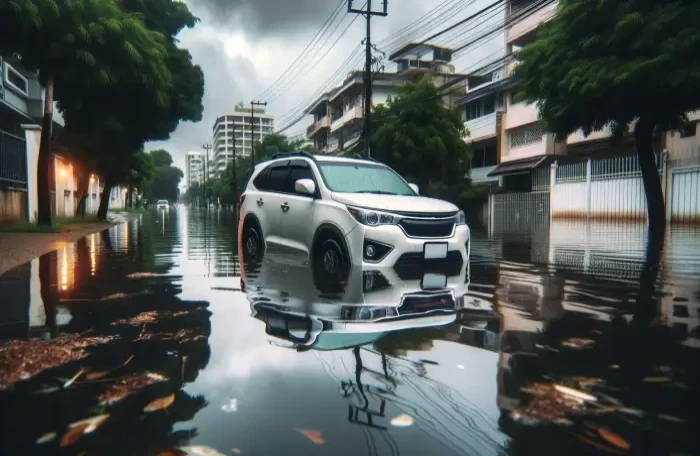Flooded Car Recovery: Your Complete Guide to Repairs and Restoration

Lila Claybourne
Sep 16, 2024

Summary
Introduction to the challenges of dealing with a flooded car
Initial safety measures and assessment
Steps to recover a flooded car
Evaluating the extent of damage
Repair options and insurance claims
Preventative measures for future floods
Conclusion and key takeaways
Introduction
Imagine waking up to find your car submerged in floodwater after a night of heavy rain. It's a sinking feeling—pun intended—knowing the potential damage and the steps you'll need to take to recover your vehicle. Flooding can cause severe and often irreparable harm to cars, with water seeping into the engine, electrical systems, and interior.
According to the National Insurance Crime Bureau (NICB), over 400,000 vehicles were damaged by flooding in the U.S. in 2017 alone. While you might be tempted to handle the situation yourself, trying to retrieve or assess the damage to your vehicle can be extremely dangerous. It's crucial to understand that consulting a professional is the safest and most effective way to navigate this situation.
Initial Safety Measures and Assessment
Safety First
Floodwaters pose significant risks, from electrical shocks to contamination, making it dangerous to approach a flooded vehicle without proper precautions. Here’s why you should leave the initial assessment to professionals:
Avoid Entering Floodwaters: Floodwaters can contain hazardous materials like sewage, chemicals, and sharp debris. Professionals have the necessary equipment and training to handle such conditions safely.
Turn Off Power Sources: If safe to do so, professionals will disconnect the car battery to prevent electrical shock or fires.
Wear Protective Gear: Experts use protective gear to shield themselves from contaminants.
Do Not Start the Car: Starting a flooded car can cause irreversible damage to the engine and electrical systems. Professionals will assess whether the car is safe to start.
Example: If your car is parked in a garage and the water has risen to cover the tires, rather than wading through the water yourself, it's safer to wait for the water to recede and contact a professional towing service.
Assess the Situation
Evaluating the extent of the flooding is crucial in determining the next steps. Here’s how to assess the damage:
Visual Inspection: Check how high the water reached. Was it below the doors, inside the cabin, or up to the dashboard?
Smell Test: A strong musty odor can indicate water intrusion inside the car.
Fluid Check: Inspect the oil, transmission, and brake fluids for water contamination, which appears milky or diluted.
Example: If the waterline is above the seats, it’s likely that the interior and many mechanical components are compromised. A professional can provide a thorough evaluation to determine the extent of the damage.
Steps to Recover a Flooded Car
Remove the Vehicle from Water
Removing a car from a flooded area is not only a logistical challenge but also a safety concern. Here’s how professionals can help:
Use a Towing Service: Towing is the safest way to move a flooded vehicle. Attempting to drive it can cause more harm, and professionals have the tools to tow the car safely.
Avoid Starting the Engine: A mechanic will ensure that the engine and other critical systems are safe before any attempt is made to start the car.
Dry Out the Car
Proper drying is crucial to prevent further damage and mold growth, a process best handled by professionals:
Open All Doors and Windows: Professionals will allow air to circulate through the car efficiently.
Remove Carpets and Mats: Experts will take out all removable items to dry them separately, ensuring thorough drying.
Use Fans and Dehumidifiers: Professionals have industrial-grade equipment to speed up the drying process.
Example: Placing a fan at the car's door can help blow air through the cabin, aiding in faster drying. Professionals will also ensure that areas prone to mold are treated accordingly.
Check Electrical Systems
Water can severely damage electrical components, and only a professional should conduct a thorough inspection:
Disconnect the Battery: This prevents electrical shorts and further damage.
Check Wiring and Fuses: Experts will look for signs of corrosion or damage.
Consult a Professional: A mechanic should inspect the car’s electrical system before attempting to start it.
Example: A mechanic can use diagnostic tools to check for any short circuits or damaged components.
Evaluating the Extent of Damage
Mechanical Components
Floodwater can wreak havoc on the engine, transmission, and other mechanical parts. A professional inspection is essential:
Inspect the Engine: Professionals look for water in the oil by checking the dipstick. Water in the oil will cause it to appear milky.
Check the Transmission Fluid: Experts ensure there’s no water contamination.
Examine the Brakes: A professional will check if water in the brake system has compromised its functionality.
Example: If the oil appears milky, it indicates water contamination, and a professional should be consulted before starting the car.
Interior and Upholstery
Water-damaged interiors can lead to mold growth and material degradation.
Steps:
Clean and Dry: Use specialized cleaners for upholstery and carpets.
Replace Damaged Materials: Heavily soaked or moldy items should be replaced.
Prevent Mold: Use mold inhibitors to protect the interior.
Example: Removing seats and upholstery to dry them thoroughly can prevent mold and mildew growth.
Checklist for Damage Evaluation
Engine Oil: Check for milky appearance.
Transmission Fluid: Inspect for water contamination.
Brake Fluid: Ensure it’s clear and not diluted.
Battery and Electrical Systems: Look for corrosion.
Interior Upholstery: Check for dampness and mold.
Repair Options and Insurance Claims
DIY Repairs
For minor flooding, some repairs can be done at home.
DIY Steps:
Replace Fluids: Change the oil, transmission fluid, and brake fluid.
Clean Upholstery: Use wet/dry vacuums and dehumidifiers.
Electrical Repairs: Only attempt if you have experience with car electronics.
Example: Changing the oil and filters can help remove water and contaminants.
Professional Repair Options and Navigating Insurance Claims
Professional Repairs
Severe flooding requires professional attention. Here’s how to proceed:
Find a Trusted Mechanic: Choose a mechanic with experience in flood-damage repairs.
Detailed Inspection: Request a thorough inspection and repair estimate from a professional.
Verify Repairs: Ensure all electrical and mechanical systems are tested post-repair.
Example: A professional mechanic can disassemble parts of the engine to check for internal water damage, ensuring that all necessary repairs are addressed.
Insurance Claims
Filing an insurance claim can help cover repair costs, but the process is complex. Professionals can assist in this process:
Document Damage: Take photos and notes of all damage, or have a professional document the damage for you.
Contact Your Insurer: Notify your insurance company immediately with professional support to ensure accuracy.
File a Claim: Provide necessary documentation, and consider seeking professional help to navigate the claim process smoothly.
Example: Keeping a detailed record of communications with your insurance company ensures a smooth claims process. Professionals can also help estimate repair costs accurately.
Tips for Dealing with Insurance Companies
Read Your Policy: Understand your coverage limits and exclusions.
Get Multiple Estimates: Provide your insurer with repair estimates from different mechanics.
Keep Records: Document all expenses and communications related to the claim.
Preventative Measures for Future Floods
Avoid Flood-Prone Areas
Park your car on higher ground during heavy rainfalls or known flood warnings.
Use Protective Covers
Waterproof car covers can provide additional protection against flooding.
Example: Investing in a high-quality car cover can protect your vehicle during unexpected storms.
Regular Maintenance
Keep your car well-maintained to minimize the impact of potential water damage.
Tips:
Check for leaks and seal them promptly.
Ensure proper drainage around your parking area.
Insightful Analysis: Long-Term Effects of Flooding on Vehicles
Impact on Vehicle Resale Value
Flood-damaged cars often have a lower resale value, even if repaired. Buyers may be wary of potential long-term issues, so professional documentation of repairs can help.
Example: A car with a history of flood damage can sell for 20-30% less than its undamaged counterpart. Professional repairs and documentation can help mitigate this loss.
Long-Term Maintenance
Flood damage can cause lingering issues, including rust, electrical problems, and mold growth, leading to ongoing maintenance costs. Professional inspections can catch these issues early.
Example: Corrosion from flood water can affect the car’s structural integrity over time, requiring frequent inspections and repairs. Professionals can ensure that your vehicle remains safe and operational.
Conclusion and Key Takeaways
Dealing with a flooded car is challenging, but prompt action can significantly reduce damage and recovery costs. Assess the situation carefully, take immediate steps to dry and inspect the car, and consult professionals for severe damage. Understanding your insurance coverage and taking preventative measures can help protect your vehicle in the future.
For comprehensive car shipping services, including during emergencies, AmeriFreight offers reliable solutions to ensure your vehicle is handled with care. By staying informed and prepared, you can effectively manage and recover from vehicle flooding incidents.
Related Posts
















